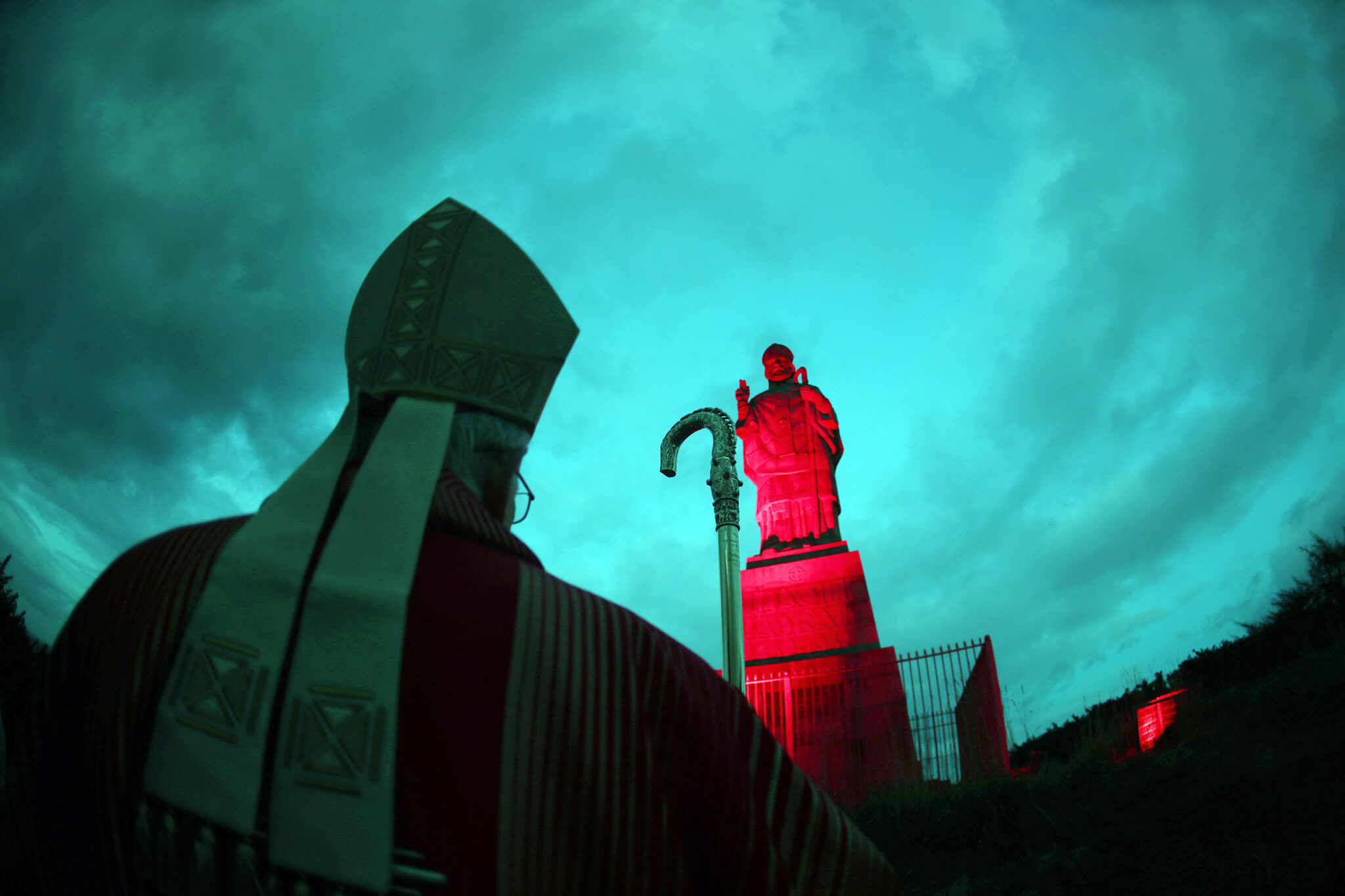The world's tallest statue of the patron saint of Ireland has been illuminated in red to highlight the plight of persecuted Christians along with religious minorities around the world.
The St Patrick monument at Saul in County Down, where the saint began his mission in Ireland in 432AD, was lit with the blessing of the Bishop of Down and Connor, Alan McGuckian SJ, whose diocese manages the national shrine.
This is the first time the imposing monument on Slieve Patrick, which rises from the top of the small mountain to a height of 47 feet, has been lit red for the "Week of Witness" that has been organised by the Catholic charity <a href="https://www.acnireland.org/"><mark style="background-color:rgba(0, 0, 0, 0)" class="has-inline-color has-vivid-cyan-blue-color">Aid to a Church in Need</mark></a> (ACN).
ACN, which supports 6,000 vulnerable communities in 140 countries, facilitates the illumination of churches, cathedrals and landmarks around the world, including the Colosseum in Rome, to mark Red Wednesday on 20 November.
Bishop McGuckian visited the monument on Slieve Patrick in his red robes, the traditional colour of martyrdom, to inaugurate the lighting of the monument. It was constructed in the 1930s to mark the 1500th anniversary of St Patrick’s arrival in 432 to begin his evangelising mission in Ireland that played a crucial part in the wider spread of Christianity and, ultimately, in the development of Western civilisation.
Slieve Patrick is the highest point at Saul, close to where the patron saint of Ireland established his first church almost 1,600 years ago.
Speaking shortly after at the vigil mass on 16 November at St Patrick’s Roman Catholic Church, held just below the monument, Bishop McGuckian told parishioners: “We lit up Patrick’s statue tonight and it will remain lit up for the week in solidarity with the Christians persecuted to this day.
"Some people think there could be 250 Christians suffering violence even unto death every single day. There are 50 countries in the world where Christians are regularly persecuted and dying often."
The bishop continued: “So this week you will look up at the mountain and you will see it at night all in red. Remember to pray for our brothers and sisters all over the world who at this very moment, this very day, are being persecuted for boasting that ‘Jesus Christ is Lord’."
Bishop McGuckian noted that the word martyr means "witness" and encouraged all Christians to witness to the truth.
“There is a great tradition of Christians saying ‘Jesus Christ is Lord’ and meaning it very, very seriously, because Jesus is their life and they know it is so important.
“Please God none of us will have to die for this but it would be wonderful if we were able to live for it. Because if our faith is worth dying for it is all the more worth living for."
Bishop McGuckian highlighted that Christians have lost their lives for proclaiming "Jesus is Lord" from the beginning of the Church.
“Men, women and children in their droves died because they would not stop saying ‘Jesus Christ is Lord’ and that is part of our story.
"The important thing is that not just that we resist but that this boast of ours – ‘Jesus Christ is Lord’ – touches our hearts because we know we have a God who is close to us and who loves us."
He continued: “As you know, in this place that we live, it was around here that this boast was first heard in Ireland. It was here that Patrick said ‘Jesus Christ is Lord’ and he invited our ancestors and now us to share in the mission and the boast.”
The bishop spoke of Fr Ragheed Ganni, who served in Down and Connor, and was killed in Iraq, along with others, in 2007 after celebrating Mass, having returned to his native country and insisting on celebrating the Eucharist.
He recalled a priest from Nigeria, working in the Diocese of Raphoe in County Donegal, who regularly received reports of priests and catechists and other Christians being killed back home.
He also referred to images of the 21 Coptic Christian construction workers who were kidnapped and killed in Libya by ISIS in 2015 because they would not deny that "Jesus is Lord" and died for it.
Michael Kelly, Director of Public Affairs for ACN in Ireland, said St Patrick’s monument was ideal to illuminate as the famous saint was himself persecuted during his mission, while some of his converts were martyred.
“In the 21st century, you might be forgiven for assuming that religious tolerance and freedom are universally recognised and respected. However, Christians across the globe continue to face varying degrees of persecution, discrimination and hostility.
"While the nature and intensity of this mistreatment differs from region to region, the phenomenon remains disturbingly widespread, affecting millions of believers in both overt and subtle ways.”
He added that the "Week of Witness" was vital for raising awareness.
“Red Wednesday is at the heart of the week, and many parishes have heeded the call to hold special liturgies and prayer vigils for those persecuted, and sadly often forgotten,” Mr Kelly said.
Knock Shrine in County Mayo and St Peter’s Cathedral in Belfast are among the Irish seats also being illuminated in red.
<a href="https://catholicherald.co.uk/cardinal-makes-red-wednesday-video-plea-for-persecuted-church/"><mark style="background-color:rgba(0, 0, 0, 0)" class="has-inline-color has-vivid-cyan-blue-color"><strong><em>RELATED: Cardinal makes Red Wednesday video plea for persecuted Church</em></strong></mark></a>
<em>Photo: Bishop McGuckian at St Patrick monument at Saul. (Credit Bill Smyth / ACN.)</em>



